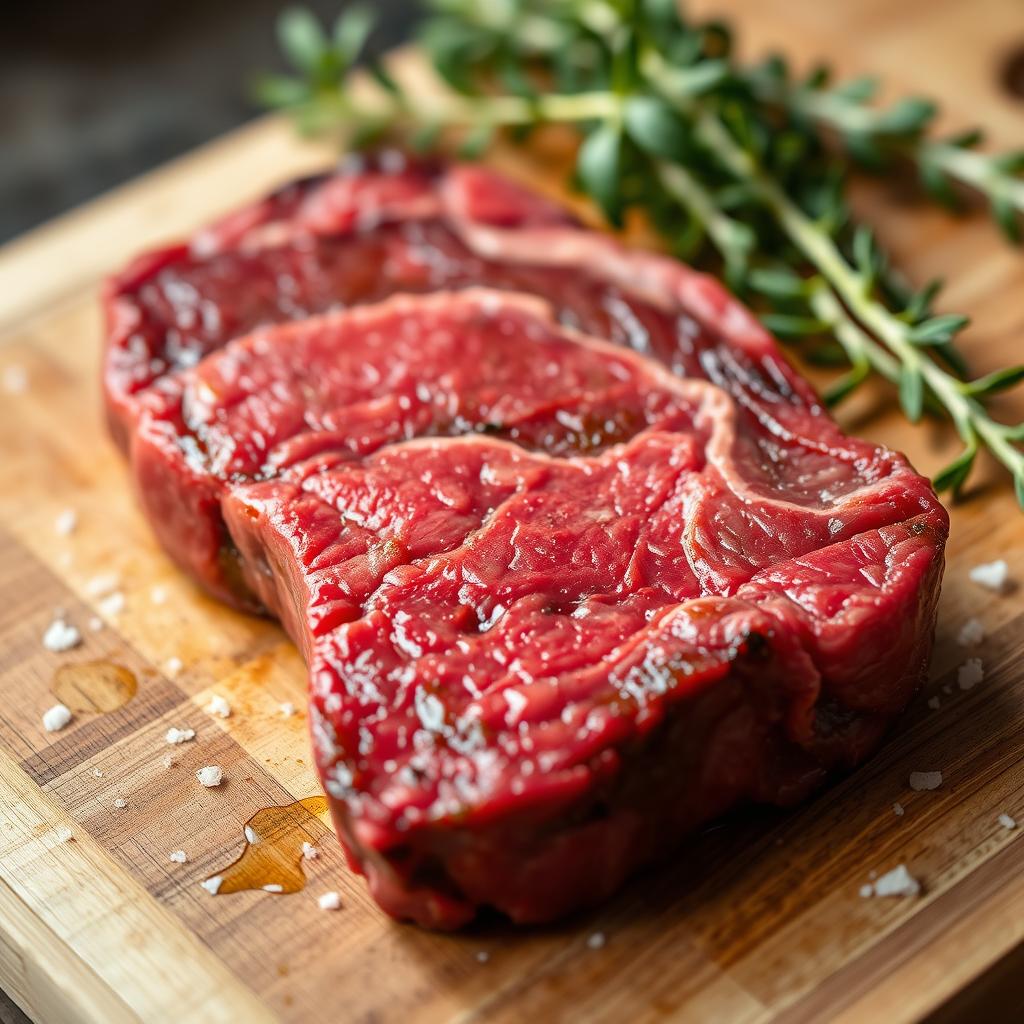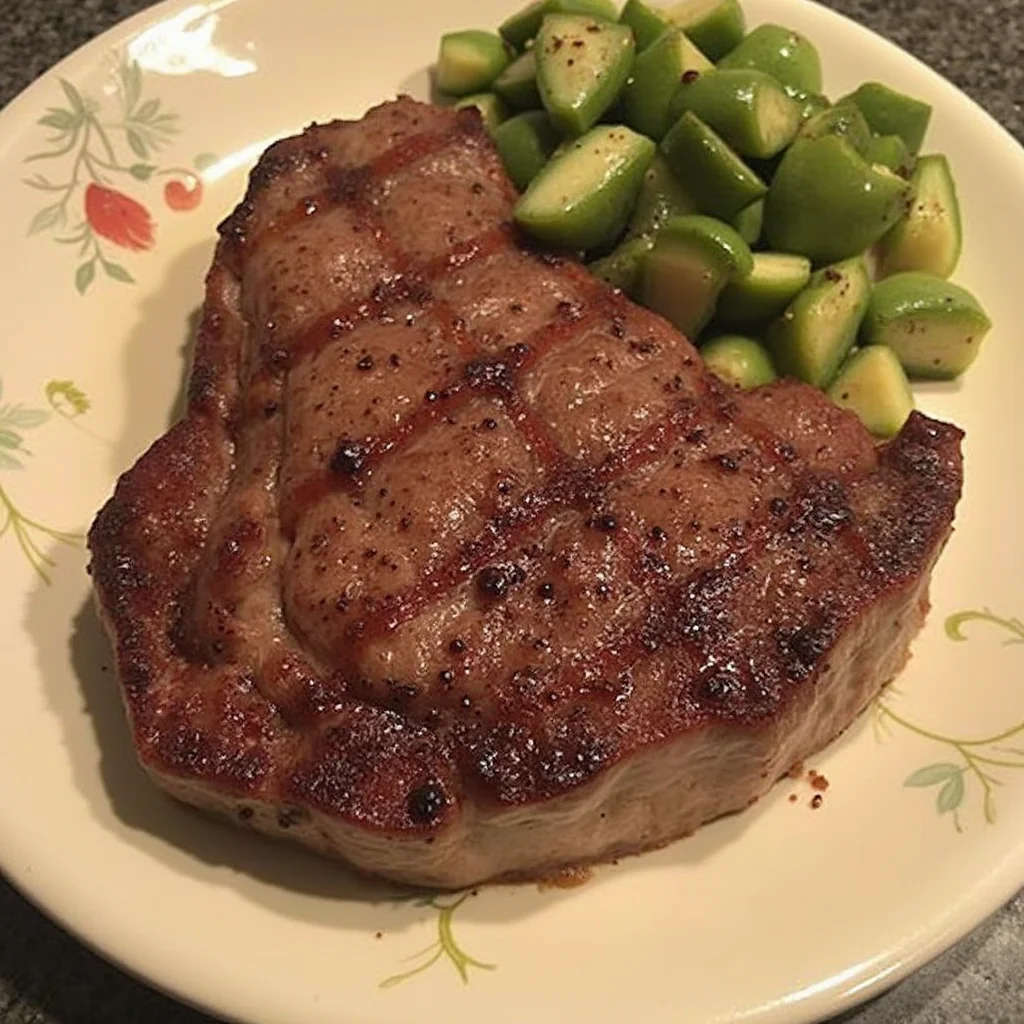The sizzle of a flat iron steak hitting a hot skillet is more than just a sound—it’s a promise of culinary excellence waiting to unfold. Growing up in a family that cherished quality beef cuts, I learned early that cooking the perfect steak isn’t just about technique. It’s an art form that connects us to generations of home cooks and professional chefs who understand the magic of transforming a simple piece of meat into a memorable meal.
Your journey to mastering flat iron steak begins with understanding that this incredible beef cut offers exceptional flavor and tenderness. Whether you’re a weekend grilling enthusiast or a home cook looking to elevate your steak recipes, this guide will walk you through everything you need to know about creating restaurant-quality flat iron steak in your own kitchen.
Table of Contents

Key Takeaways
- Flat iron steak offers exceptional flavor and tenderness
- Proper preparation is crucial for perfect results
- Temperature control determines steak doneness
- Marinades can enhance the natural beef flavor
- Resting meat after cooking ensures maximum juiciness
Understanding Flat Iron Steak: A Premium Beef Cut
The flat iron steak is a standout in the world of butcher cuts. It’s known for its amazing flavor and tenderness. This cut has gained popularity quickly among steak lovers.

This steak comes from the beef shoulder. It has a mix of rich marbling and lean meat. Butchers love it for its quality and beefy taste.
What Makes Flat Iron Special
- Exceptional tenderness rivaling premium cuts
- Rich, robust beef flavor
- Consistent marbling throughout the meat
- More affordable than traditional premium steaks
Anatomy of the Cut
The flat iron steak is from the top blade muscle group. It’s different from flank steak because of its better marbling and tenderness. It’s carefully cut to remove tough tissues, making it smooth to eat.
Choosing Quality Flat Iron Steak
| Quality Indicator | What to Look For |
|---|---|
| Marbling | Fine, white streaks throughout the meat |
| Color | Bright red with minimal browning |
| Texture | Smooth surface, minimal surface moisture |
| Thickness | 1-1.5 inches recommended for optimal cooking |
“A great flat iron steak is all about quality and preparation.” – Professional Chef
When picking your flat iron steak, go to a trusted butcher. They know the differences in beef cuts. Look for meat with good marbling and a fresh look for the best taste.
Essential Tools and Equipment for Cooking Steak

Getting the perfect steak is more than just good meat. You need the right tools and equipment for grilling and barbecue. Both pros and home cooks agree: the right gear makes a big difference in your steak recipes.
Here are the key tools you need for your steak cooking arsenal:
- High-quality meat thermometer
- Heavy-duty tongs
- Cast iron skillet or grill grates
- Sharp chef’s knife
- Cutting board
Choosing the right equipment changes your cooking game. A good meat thermometer ensures your steak is cooked just right. It prevents it from being too raw or too well done.
| Tool | Purpose | Recommended Type |
|---|---|---|
| Meat Thermometer | Check internal temperature | Digital instant-read |
| Grill/Skillet | Cooking surface | Cast iron |
| Tongs | Handling meat | Long, stainless steel |
“The right tool can elevate a good steak to a great dining experience.” – Professional Chef
Pro tip: Invest in quality equipment that will last multiple cooking seasons and help you consistently create delicious steak recipes.
Preparing Your Flat Iron Steak Before Cooking
Getting your flat iron steak ready is key to making it amazing. Knowing how to handle beef cuts can take your cooking to the next level. This ensures a tasty meal every time.
Proper Thawing Techniques
Thawing your steak right is vital for keeping its quality and stopping bacteria growth. Always use these safe thawing ways:
- Refrigerator thawing: Move the steak from freezer to fridge 24 hours before cooking
- Cold water method: Put sealed steak in cold water, change water every 30 minutes
- Never thaw at room temperature, as it can cause bacteria to grow
Trimming and Preparation Steps
When prepping your beef, trimming it well can make it tender and tasty. Use a sharp knife to cut off extra fat. Leave a thin layer for moisture and flavor.
| Preparation Step | Purpose |
|---|---|
| Remove silver skin | Improves meat texture |
| Pat dry with paper towels | Ensures better marinating and searing |
| Trim excess fat | Prevents flare-ups and uneven cooking |
Temperature Considerations
Starting with the right temperature is key to tenderizing your steak. Let it rest at room temperature for 30-45 minutes before cooking. This helps cook it evenly and reach your perfect doneness.
“Great steak preparation is an art that starts long before the heat touches the meat.” – Professional Chef
By using these prep steps, you’ll get a fantastic flat iron steak. It will be both flavorful and tender.
Best Marinades and Seasonings for Enhanced Flavor
Take your flat iron steak to the next level by mastering marinating and seasoning. Recipes that use smart marinating can change the meat’s texture and boost its taste.
Start by knowing the right ingredients for tenderizing. Salt, acid, and enzymes are key. They help break down muscle fibers and improve meat quality.
- Classic Herb Marinade
- Fresh rosemary
- Garlic
- Olive oil
- Black pepper
- Citrus-Based Tenderizing Mix
- Lime juice
- Soy sauce
- Ginger
- Honey
“The secret to an unforgettable steak lies not just in cooking, but in preparation.” – Professional Chef
Keep these tips in mind for marinating:
- Marinate for 30 minutes to 2 hours
- Use non-reactive containers
- Refrigerate during marinating
- Pat meat dry before cooking
Try out different flavors to find your favorite steak recipe. The right marinade can make any cut taste like it’s from a fancy restaurant.
Perfect Temperature and Timing Guide
Cooking flat iron steak needs precision and knowing about temperature control. Your grilling success comes from knowing how to get the perfect doneness. This keeps the steak’s flavor and tenderness.
Cooking a flat iron steak is more about science than art. Every degree is important for the perfect barbecue experience.
Rare to Well-Done Temperature Guidelines
- Rare: 125°F (internal temperature) – deep red center
- Medium Rare: 135°F – warm red center
- Medium: 145°F – pink center
- Medium Well: 150°F – slight pink center
- Well Done: 160°F – little to no pink
Using Meat Thermometers Effectively
A good meat thermometer is key for steak recipes. Put the probe in the thickest part of the steak, away from fat or bone. Digital instant-read thermometers give the most accurate readings fast.
“The difference between a good steak and a great steak is often just a few degrees.” – Professional Chef
Understanding Resting Times
| Steak Thickness | Recommended Resting Time |
|---|---|
| ½ inch | 5 minutes |
| 1 inch | 7-10 minutes |
| 1½ inches | 10-15 minutes |
Resting lets juices spread out, making the steak more flavorful and tender. Cover the meat with aluminum foil during resting to keep it warm without cooking more.
Grilling Methods for Flat Iron Steak
Grilling flat iron steak is an art that needs the right heat and techniques. With your skills, this tasty cut can become a delicious dish. The key is in the strategy.
There are two main ways to grill a iron steak:
- Direct heat grilling for intense searing
- Indirect heat method for more controlled cooking
For direct heat, set your grill to 450-500°F. This high heat helps create great grill marks and keeps the steak juicy.
“A perfectly grilled flat iron steak is about precision and technique, not just high heat.”
Here’s how to grill it right:
- Preheat the grill well
- Pat the steak dry before seasoning
- Place steak at a 45-degree angle for perfect crosshatch marks
- Flip only once during cooking
| Grilling Method | Temperature | Cooking Time |
|---|---|---|
| Direct High Heat | 450-500°F | 4-5 minutes per side |
| Indirect Heat | 350-400°F | 6-7 minutes per side |
Watch for flare-ups and adjust the steak’s position if needed. This way, you’ll get a smoky, perfectly cooked steak every time.
Pan-Searing Techniques for Indoor Cooking
Learning to cook steak indoors can make your flat iron steak recipes amazing. Pan-searing brings out the rich flavors in beef, making your meal taste like it’s from a restaurant.
Indoor cooking is great when you can’t grill outside. The right method can give you a perfectly cooked flat iron steak with a golden-brown crust.
Cast Iron Skillet Methods
Cast iron skillets are perfect for cooking steak. They keep heat well and cook evenly, helping you get a great sear.
- Preheat the skillet until it’s smoking hot
- Use high smoke point oils like avocado or grapeseed
- Ensure the flat iron steak is pat dry before cooking
- Cook 3-4 minutes per side for medium-rare
Butter Basting Tips
Butter basting adds amazing flavor and a glossy look to your steak.
- Add butter during the last two minutes of cooking
- Tilt the pan and continuously spoon melted butter over the steak
- Use fresh herbs like thyme or rosemary for extra aromatics
“The secret to a perfect pan-seared steak is patience and high heat.” – Professional Chef
With these tips, you’ll make your flat iron steak a dish that’s as good as any steakhouse.
Common Cooking Mistakes to Avoid
Mastering steak recipes means knowing the common mistakes in grilling and cooking. Flat iron steak is especially tricky for home cooks aiming for restaurant-quality dishes.
When cooking barbecue-style flat iron steak, several key mistakes can ruin your meal:
- Skipping meat temperature preparation
- Incorrect seasoning techniques
- Inappropriate heat management
- Neglecting resting times
Temperature mistakes are the biggest error in steak cooking. Putting cold meat on hot grills leads to uneven cooking and a tough texture.
“Great steak starts with understanding heat and technique” – Professional Chef
Seasoning is key to improving your flat iron steak. Over-salting or under-seasoning can greatly affect the taste.
| Mistake | Consequence | Solution |
|---|---|---|
| Overcooking | Dry, Tough Meat | Use Meat Thermometer |
| Cold Meat | Uneven Cooking | Rest at Room Temperature |
| Wrong Seasoning | Bland Flavor | Salt Properly Before Cooking |
Knowing these common mistakes will help you make your steak amazing. This ensures a great grilling experience every time.
Serving Suggestions and Pairings
Creating the perfect meal is more than just cooking a great flat iron steak. The right sides and wines can make your meal unforgettable. Choosing the right sides and wines turns your dinner into a feast for the senses.
Wine Recommendations
Finding the perfect wine for your flat iron steak can really bring out its flavors. Here are some top picks:
- Cabernet Sauvignon: A classic bold red that matches the steak’s robust profile
- Malbec: Offers smooth tannins that complement the meat’s texture
- Syrah/Shiraz: Provides a peppery undertone that elevates the steak’s taste
“A great wine turns a meal into an experience.” – Unknown Chef
Side Dish Options
Balance your flat iron steak with sides that enhance its rich flavor. Here are some great options:
- Roasted garlic mashed potatoes
- Grilled asparagus with herb butter
- Seasonal roasted vegetables
- Creamy blue cheese risotto
Pro tip: Choose sides that offer texture and flavor contrasts to your flat iron steak. A well-thought-out plate not only fills you up but also leaves a lasting impression.
Storing and Reheating Leftover Steak
Keeping your flat iron steak’s flavor fresh is key. It’s important to store and reheat it right. This way, you can enjoy its great taste and texture.
Here’s how to store leftover steak correctly:
- Cool the steak completely before storage
- Wrap tightly in aluminum foil or plastic wrap
- Place in an airtight container
- Refrigerate within two hours of cooking
“The key to great steak recipes is preserving the meat’s original quality and flavor.” – Professional Chef
Reheating steak can be tricky. Different methods suit different tastes:
| Reheating Method | Best For | Temperature |
|---|---|---|
| Oven | Maintaining moisture | 250°F (low and slow) |
| Skillet | Crispy exterior | Medium-high heat |
| Microwave | Quick warming | 30-second intervals |
Pro tip: Let your steak rest at room temperature for 10-15 minutes before reheating. This helps it warm evenly. Don’t reheat it too many times, as it can dry out.
Storage duration tip: Eat refrigerated leftover steak within 3-4 days for the best taste and safety.
Alternative Cooking Methods
Trying out different cooking techniques can make your steak recipes better. It can also improve your cooking skills. While traditional ways are good, new methods offer special ways to cook flat iron steak.
Broiling Techniques
Broiling is a great way to cook beef cuts like steak. It uses high heat to give your steak a restaurant-quality taste at home. Here’s how to broil your steak well:
- Position oven rack 3-4 inches from heat source
- Preheat broiler to high temperature
- Pat steak dry with paper towels
- Season generously with salt and pepper
- Cook 4-5 minutes per side for medium-rare
Sous Vide Approach
Sous vide cooking lets you control the temperature for perfect steak. It makes sure your steak is cooked evenly and stays tender.
| Doneness | Temperature | Cooking Time |
|---|---|---|
| Rare | 125°F | 1-2 hours |
| Medium-Rare | 135°F | 1-2 hours |
| Medium | 145°F | 1-2 hours |
“Mastering alternative cooking methods expands your culinary repertoire and ensures consistently delicious flat iron steak.” – Professional Chef
Both broiling and sous vide have their own benefits for steak. Try them out to find your favorite way to cook. You’ll discover new flavors for your favorite beef cuts.
Conclusion
Cooking the perfect flat iron steak is an art. It combines technique, passion, and creativity. By understanding this exceptional beef cut, you can make any meal unforgettable. The secret is to try different recipes and techniques to highlight its rich flavor and tender texture.
Exploring various cooking methods like grilling and pan-searing gives you a wide range of options. Each method has its own benefits, letting you choose based on your kitchen and preferences. Remember, the more you practice, the better you’ll get at cooking beef cuts like flat iron steak.
Whether you’re cooking at home or dreaming of becoming a chef, these skills will improve your cooking. Don’t hesitate to try new marinades, seasonings, and cooking temperatures. The flat iron steak is both forgiving and elegant, perfect for any meal.
Now you have the power to make amazing meals in your kitchen. Keep learning, trust your instincts, and enjoy the tasty results of your cooking journey with flat iron steak.


1 thought on “How to Cook the Perfect Flat Iron Steak”